
South Union Foxhounds, Roberts Cove. Photo © Catherine Power
Hunting & Hounds
Foxhunting as a sport is defined by the IMFHA as:
The hunting of the Fox in his wild and natural state with a pack of registered foxhounds. No pack of foxhounds either Registered or Associated with the IMFHA, nor any Master(s), Hunt Representative or Hunt Chairman, who is a Member of, or affiliated to the IMFHA shall be allowed or shall allow his/her employees, agents or Hunt Staff to hunt a fox in any way that is inconsistent with this precept.
The objective of foxhunting as it is practiced in Ireland places the emphasis on the art of venery and not the death of a fox. On occasion when hounds catch their fox, death is instantaneous. In foxhunting either the fox is killed or he gets clean away.
Fox Hunting
Organised foxhunting plays an important part in rural life not only as a recreation but it also plays a critical role in habitat management and preservation. Through foxhunting many small bogs, coverts and hedgerows, which provide habitats for foxes, small mammals, birds and insects, are protected and preserved. This voluntary conservation role goes largely unrecognised as most of the coverts, bogs and hedgerows that are preserved belong to farmers and supporters of the hunt.
Foxhunting contributes enormously to the local economy, as the study (The Economic Significance of Field Sports in Ireland) carried out by U.C.D. in 1998 detailed. Amongst the many trades and professions that earn some of their income through hunting are the farmers and feed merchants who sell hay, straw, haylage and oats to local horse owners, equestrian centres who provide hirelings, livery or who sell horses, farriers, saddlers, vets, hoteliers and publicans. To some degree each of these trades depend upon the activities of the Hunt Club as part of their income.
Foxhunting was never more popular or better supported than it is today and the main concern of most hunt clubs is maintaining the balance between the demand to go hunting and the need to restrict followers to a reasonable number.
The Quarry
Surprisingly few people have seen a fox close up and others are mislead by its cuddly appearance. After 140 years of organised foxhunting in Ireland, the red fox can be found all over the country and in very good shape. The fox is a well-conserved species. While the fox commands respect, it should not command sentimentality. Left unchecked, fox populations would expand and destroy the delicate balance of nature and cause widespread damage. Being an opportunistic predator, the fox will kill poultry, wildfowl, newborn lambs and piglets beyond the needs of its staple diet of small wild mammals, insects and worms.
The fox is a hunter and covers considerable distances hunting for food or in search of a mate. Like all wild animals when threatened, the fox attempts to put up an adequate "flight distance" between itself and a potential enemy. This is a natural survival instinct. It is worth bearing in mind that the other methods of fox control - snares, traps, gassing and poisoning - all carry a high risk of a lingering death not only to the fox but to other mammals, while the hunted fox is either killed outright or gets away.
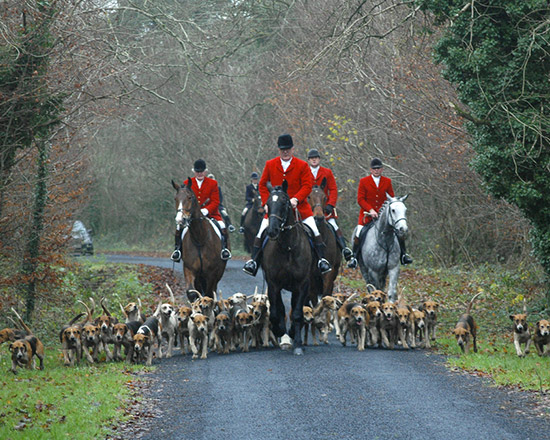
Galway Blazers, Coorheen. Photo © Noel Mullins.
Foxhounds
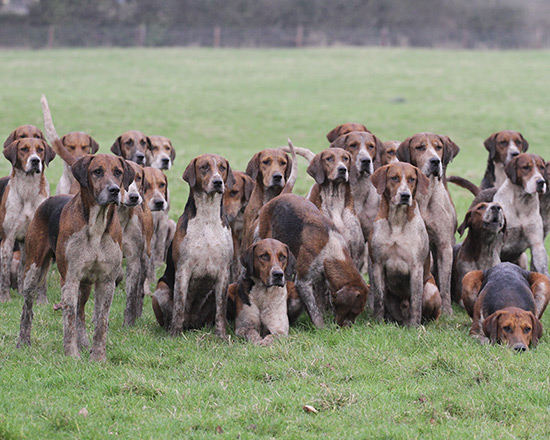
County Limerick Foxhounds. Photo © Catherine Power.
There are 41 packs of hounds fully registered with the Irish Masters of Foxhounds Association (IMFHA). Each registered pack of foxhounds has its own defined territory or hunt country and the hunt kennels are usually situated in the heart of that country.
The minimum number of foxhounds needed to maintain a registered pack is 10 couple (twenty hounds) although most hunts maintain in excess of thirty couple. Hounds are cared for by the Hunt Staff comprising the huntsman and his assistant, the "whipper-in". Some hunts may also have a kennelman and a hunt groom to look after the hunt horses.
During the nineteenth century the sport of foxhunting began to develop into the structured organisation that exists today. In the earlier years, packs of hounds belonged to local families and disputes occasionally arose over hunt boundaries or their respective hunting countries. Families such as the Nicholsons of Meath, the O'Driscolls of West Cork, the McCalmonts of Kilkenny, the Filgates of Louth and the famous Ryans of Scarteen, still survive to this day and have had strong connections with foxhunting in Ireland . In time, these hunts developed into the county packs that exist today and now there are few counties which do not have a pack of foxhounds affiliated to the IMFHA. Collectively these hunts are the largest single employer amongst the associations which represent hunting with hounds.
Most famous amongst these packs is probably the Scarteen Hounds of Tipperary/Limerick. Known as "the Black and Tans", this pack comprises 23-inch pure-bred Kerry Beagles. They are unique and have been in the possession of the Ryan family for over 300 years. The Muskerry Hunt is the oldest pack in the country having been established in 1743, while the Duhallow is the oldest pack with continuous record having been established in 1745. The Kildare Hounds have records to show that a hunt club existed in Kildare as far back as 1766. Other hunts with a rich and long tradition include the Ballymacad Hunt centred around Oldcastle in Co. Meath who celebrated their bicentennial in 1997 and the Kilkenny Hunt, the oldest county pack in the country, also established in 1797.
The importance of these long established and organised packs is that through their experience, local knowledge, organisation and control, the coverts and countryside have been preserved over the centuries. The protection afforded to these coverts, woodlands and bogs that provide a habitat for the fox and for many other insects, birds, small mammals and plants can only be attributed to the fact that they either belonged to the hunt club or to its farmers and landowners. Many of these varied habitats would have long since disappeared if it had not been for their historical and continued association with hunting.
The Field
In hunting language the field is the term used for the mounted followers that follow the hounds and the hunt staff. The field are under the control and instruction of the Field Master - where he goes they may go.
Sometimes during a hunt only the hunt staff and the Masters may follow a pack, and in this case, the Field Master may have to take an alternative route or travel by road to catch up with the hounds. At the back of the field may be found "gate shutters". These are two or more members of the hunt who may have been appointed to shut gates and ensure that any fence jumped is stockproof after the hunt has gone through.
Gate Shutters report any fences to be mended to the kennel staff or to whomever is responsible. At the end of a days hunting either the huntsman or Master (or both) may visit some of the local farms to thank the landowners for allowing the hunt access to their property. For many who hunt or follow the hunt, the real thrill is the sight of watching a huntsman and his hounds at work. In the first instance they must find their fox, which is not an easy task, and, following that, they must have sufficient scenting powers to follow the line of that fox.
In the end, they will either lose their fox, mark him to ground or catch him. It is not always inevitable that they will find a fox or even that they will catch one - very often hunts have a "blank day". In addition the fox is a cunning and crafty animal and he uses many tricks to lose the hounds, like running through a field of slurry, crossing a river or running the length of a high wall. the odds are very often stacked in his favour.
Because of its popularity, foxhunting enjoys the support of a large number of car followers. These followers are the very backbone of hunting and their assistance is often invaluable. They enjoy hunting every bit as much as those on horseback - their knowledge of the countryside, the ways of the fox and his usual course is often invaluable. They enjoy hunting every bit as much as those on horse back - their knowledge of the countryside, the ways of the fox and his usual course is exceptional and often uncanny.
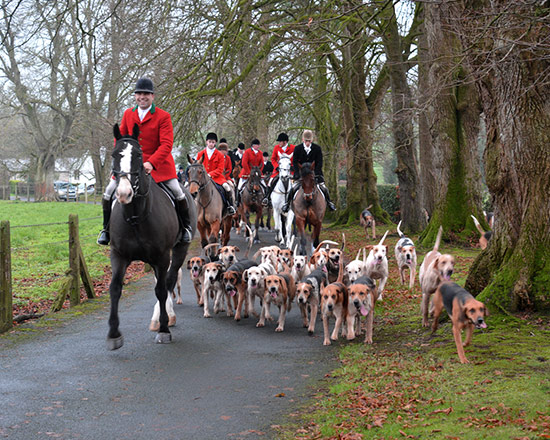
South Tyrone Foxhounds. Photo © Noel Mullins
Hound Shows
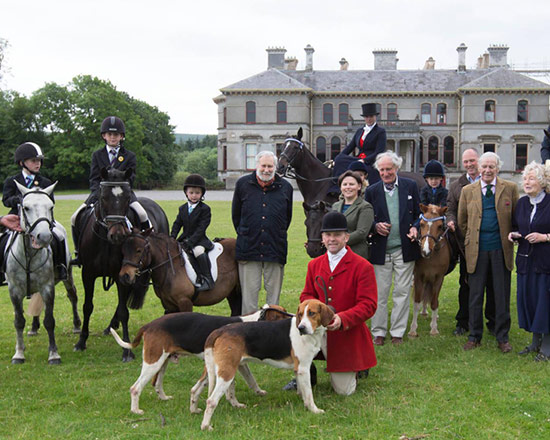
Since 1909 the IMFHA have held an annual hound show, which until 1985 was held in Clonmel, Co Tipperary. For a number of years it was then held at Clonshire, Co. Limerick, but since 2000 it takes places at Stradbally Hall, Co. Laois. Many valuable cups are eagerly competed for by packs from all over Ireland. Over the years Irish packs have shown their best hounds at the world-renowned Peterborough Royal Foxhound Show in the UK and have successfully won coveted prizes beating hounds from the top British packs.
Foxhounds are registered in the Foxhound Kennel Stud Book, which began in 1800 to trace the pedigrees of hounds. Irish hounds are well regarded abroad and Irish stallion hounds are routinely used by packs across the Irish Sea. Masters of Foxhounds from Ireland are regularly invited to judge at British hound shows, giving them the opportunity to compare and contrast the various bloodlines.
Point-to-Points
In 1923 a committee was selected for the purpose of framing rules for the regulation of point-to-point steeplechases in Ireland. The Stewards of the Irish National Hunt Steeplechase Committee (I.N.H.S.) granted leave to the IMFHA to run point-to-points under their auspices, subject to certain conditions - an arrangement, which continues to the present. Hunts run point-to-point races as fundraisers, they are run by enthusiastic volunteers and many a champion steeplechaser began its career on the Irish point-to-point field including the famous mare Dawn Run, Arkle, and Best Mate.
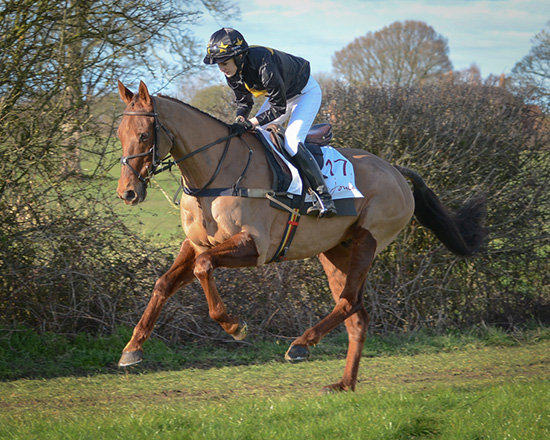
Hunt Chases
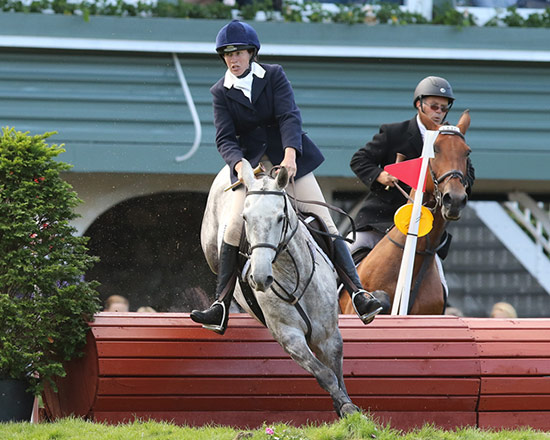
Hazel Valentine leads the way for the Kildare Hunt in the 2016 RDS Hunt Chase. Photo © Dave Barrett - www.davbar.com
The immensely popular hunt chases, now regular features of agricultural shows around the country, are an innovation developed by Thady Ryan MFH of the Scarteen Hunt under the auspices of the IMFHA. Their popularity has spread to the UK and Irish teams have competed there and won several championships. The Royal Dublin Society hosts the most exciting team chase competition of all and hunts that are members of the IMFHA are invited to compete.
Many hunts parade their hounds at the annual Dublin Horse Show. Hounds have also paraded at other functions from time to time, such as the Special Olympics and the European Eventing Championship.
